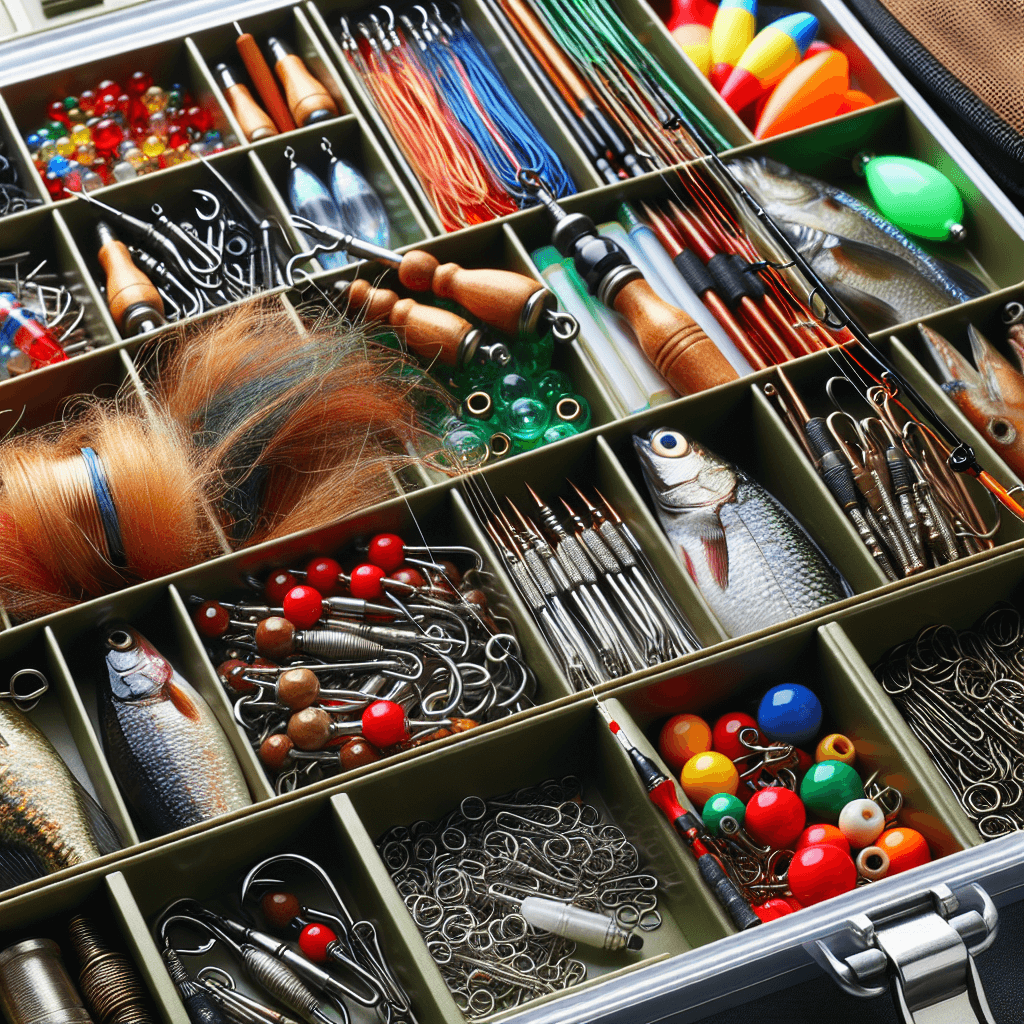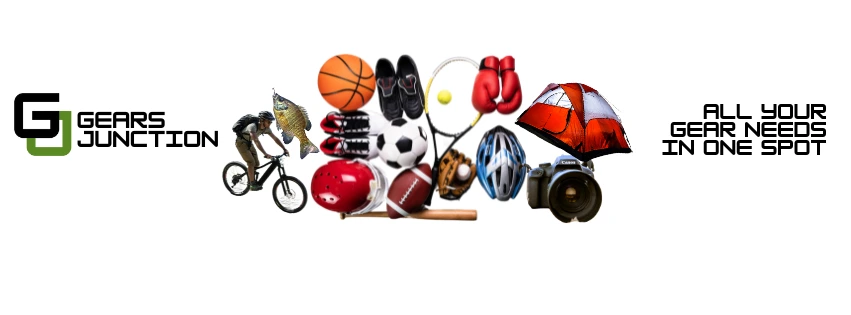When it comes to the world of fishing, having the right tools and accessories in your tackle box can make all the difference. Whether you’re a seasoned angler or just starting out, knowing what essentials to pack can greatly enhance your fishing experience. From hooks and lines to pliers and bait, this article will guide you through the must-have items that should always be in your tackle box. So grab your fishing gear and let’s dive into the world of angling essentials!
Rods and Reels
Choosing the right rod
When it comes to choosing the right fishing rod, there are a few factors to consider. First, think about the type of fishing you’ll be doing. Different rods are designed for different techniques, such as casting or trolling. Next, consider the rod’s power and action. Power refers to the rod’s strength and is typically categorized as light, medium, or heavy. Action refers to how the rod flexes and is categorized as fast, medium, or slow. Finally, think about the type of material the rod is made of. Common materials include graphite, fiberglass, and composite.
Selecting the appropriate reel
Choosing the right fishing reel is equally important as choosing the right rod. Reels come in various types, including spinning reels, baitcasting reels, and fly fishing reels. Consider the type of fishing you’ll be doing and your level of experience. Spinning reels are easy to use and popular among beginners, while baitcasting reels offer more control and are favored by experienced anglers. Fly fishing reels, on the other hand, are specifically designed for fly fishing techniques.
Spinning reels
Spinning reels are a great option for beginners due to their ease of use. They are designed to hang beneath the rod and have a fixed spool. Spinning reels are versatile and can be used for a variety of fishing techniques, including freshwater and saltwater fishing. They are known for their smooth drag system, which allows for easy line control and casting. When choosing a spinning reel, consider its size, gear ratio, and drag system.
Baitcasting reels
Baitcasting reels are often preferred by experienced anglers for their precision and control. Unlike spinning reels, baitcasting reels are mounted on top of the rod and have a revolving spool. They are typically used for larger fish species and heavier fishing lines. Baitcasting reels require more practice to master, as they can be prone to backlash if not operated properly. When selecting a baitcasting reel, consider its gear ratio, spool size, and braking system.
Fly fishing reels
Fly fishing reels are specifically designed for fly fishing, a technique that involves casting a lightweight fly and an artificial fly line. Fly fishing reels have a large arbor, which allows for quick line retrieval. They also have a smooth drag system, as fighting fish on a fly rod can be especially challenging. When choosing a fly fishing reel, consider its weight, drag system, and arbor size.
Fishing Lines and Leaders
Monofilament lines
Monofilament fishing lines are popular among anglers due to their versatility and affordability. They are made from a single strand of nylon, which offers good knot strength and abrasion resistance. Monofilament lines come in various strengths and are suitable for a wide range of fishing techniques and fish species. They are buoyant and have low visibility underwater, making them ideal for topwater fishing.
Fluorocarbon lines
Fluorocarbon fishing lines are known for their invisibility underwater. They are made from a dense polymer that refracts light similarly to water, making them nearly invisible to fish. Fluorocarbon lines have excellent abrasion resistance and are more sensitive than monofilament lines. They are often used as leaders or tippets to enhance the invisibility of the fishing setup.
Braided lines
Braided fishing lines are composed of multiple strands of synthetic fibers, such as Spectra or Dyneema. They are incredibly strong and have minimal stretch, allowing for excellent sensitivity and hook-setting power. Braided lines have a small diameter, which allows for long casts and increased line capacity. However, they are more visible in the water and may require the use of a monofilament or fluorocarbon leader.
Choosing the right line strength
Choosing the right line strength depends on the fish species you’re targeting and the fishing conditions. Lighter lines are suitable for smaller fish and finesse techniques, while heavier lines are necessary for larger fish and heavy cover situations. It’s important to match the line strength to the rod and reel you’re using, as exceeding the recommended line strength may result in equipment failure.
Including fishing leaders
Fishing leaders are short sections of fishing line that are added between the main fishing line and the hook or lure. Leaders provide added strength, abrasion resistance, and invisibility to the fishing setup. They are often made of fluorocarbon or monofilament material and are available in various lengths and strengths. Using a leader can help increase your chances of landing a fish, particularly in situations where fish are line-shy or there is a risk of abrasion from rocks or structure.

Hooks and Baits
Different types of fishing hooks
Fishing hooks come in various shapes, sizes, and styles, each designed for specific fishing techniques and fish species. Common types of fishing hooks include round bend hooks, worm hooks, treble hooks, and circle hooks. Round bend hooks are versatile and widely used for a variety of fishing applications. Worm hooks have a unique bend that allows for the effective rigging of soft plastic baits. Treble hooks have three points and are commonly used on lures. Circle hooks are designed to hook fish in the corner of the mouth, reducing the risk of deep hooking and increasing the chances of a successful catch and release.
Choosing the right size and shape
Choosing the right size and shape of fishing hook depends on the fish species you’re targeting and the type of bait you’ll be using. Smaller hooks are generally used for smaller fish and finesse techniques, while larger hooks are suitable for larger fish and live bait fishing. The shape of the hook can also affect the way it performs. For example, wide gap hooks are ideal for presenting larger baits, while offset hooks help improve hook sets on soft plastic baits.
Live baits
Live baits, such as worms, minnows, and crickets, are a popular choice among anglers. They provide a natural and enticing presentation to attract fish. When using live baits, it’s important to handle them carefully and keep them alive and healthy. Make sure to use the appropriate hook size and rigging technique to ensure the bait stays on the hook and swims naturally in the water.
Artificial lures
Artificial lures are designed to imitate the appearance and movement of natural prey, such as fish or insects. They come in various shapes, sizes, and colors, and are versatile for different fishing techniques. Some commonly used artificial lures include crankbaits, spinnerbaits, soft plastics, and topwater lures. When selecting artificial lures, consider the fish species you’re targeting and the prevailing fishing conditions.
Weights and Sinkers
Split shot sinkers
Split shot sinkers are small, round weights that can be easily added or removed from the fishing line. They are commonly used to add weight to the line for better control and casting distance. Split shot sinkers can be positioned at various points along the fishing line to adjust the depth at which the bait or lure is presented.
Bell sinkers
Bell sinkers, also known as bell weights or slip sinkers, are bell-shaped weights that slide freely on the fishing line. They are often used in freshwater and saltwater fishing to allow a natural presentation of the bait. Bell sinkers are particularly effective when fishing in areas with strong currents, as they help the bait stay near the bottom.
Drop shot weights
Drop shot weights are specifically designed for drop shot fishing, a finesse technique that involves suspending the bait above the bottom. They consist of a weight attached to the bottom of the fishing line, with a hook tied a short distance above. The weight keeps the line vertical in the water, allowing for precise control and sensitivity.
Bullet weights
Bullet weights, also known as bullet sinkers, are shaped like a bullet and are designed to glide through cover without getting snagged. They are commonly used in Texas rigging and Carolina rigging techniques, where the weight is positioned in front of the bait for a natural presentation. Bullet weights come in various sizes and weights, allowing for customization based on the fishing conditions.
Using the right weight for different fishing techniques
Using the right weight for different fishing techniques is crucial for success. Lighter weights are suitable for finesse techniques and when fish are less active, while heavier weights are necessary for deep water fishing or fishing in strong currents. It’s important to experiment with different weights and adjust them accordingly to achieve the desired presentation and depth.
Bobbers and Floats
Different types of bobbers
Bobbers, also known as floats or strike indicators, are used to suspend bait at a specific depth. They provide visual cues when a fish bites, as they bob or disappear beneath the water’s surface. Bobbers come in various shapes and sizes, including round bobbers, slip bobbers, and pencil bobbers.
Slip bobbers
Slip bobbers are designed to slide freely on the fishing line and allow for precise depth control. They are commonly used when fishing at different depths or when fish are suspended at a specific level. Slip bobbers can be adjusted easily by adding or removing a bobber stop on the fishing line.
Fixed bobbers
Fixed bobbers, also known as clip-on bobbers or traditional bobbers, are attached to the fishing line using a spring-loaded clip. They are simple and easy to use, making them a popular choice among beginners and children. Fixed bobbers are suitable for fishing at a fixed depth or when fish are feeding near the surface.
Using floats for targeting specific fish species
Floats, or floats, can be used to target specific fish species by adjusting the depth at which the bait is presented. For example, if targeting panfish near the surface, a fixed bobber can be used to suspend the bait just below the water’s surface. On the other hand, if targeting bottom-dwelling fish, a slip bobber can be set to the desired depth above the bottom.
Fishing Nets
Landing nets
Landing nets are essential for safely landing and handling fish. They are designed to minimize harm to the fish and provide a secure method of bringing the fish into the boat or onto the shore. Landing nets come in various sizes and materials, such as nylon, rubber, or mesh. It’s important to choose a landing net with a large enough hoop size to accommodate the size of fish you’re targeting.
Choosing the appropriate net size
The size of the landing net should be determined by the fish species you’re targeting. Smaller landing nets are suitable for panfish and trout, while larger landing nets are necessary for bigger game fish. It’s also important to consider the net’s handle length, as longer handles provide better reach and maneuverability.
Rubber mesh vs. nylon mesh
Landing nets are available with either rubber mesh or nylon mesh. Rubber mesh is preferred by catch-and-release anglers as it is less likely to damage the fish’s protective slime layer and reduces the risk of injury. Nylon mesh, on the other hand, is more cost-effective and widely available. Both materials have their advantages, so it’s important to choose based on personal preference and fishing practices.
Folding nets for increased portability
Folding nets are designed to be compact and portable, making them a great option for anglers on the go. They often feature collapsible frames that can be easily folded and stored in a backpack or tackle box. Folding nets are lightweight and convenient, without compromising on the net’s functionality or durability.

Pliers and Fishing Tools
Needle-nose pliers
Needle-nose pliers are a versatile tool that every angler should have in their tackle box. They are essential for removing hooks from fish and provide a secure grip for tasks such as cutting line, crimping split shot sinkers, or bending wire. Needle-nose pliers often come with additional features, like line cutters and split ring openers, making them a multipurpose tool for various fishing tasks.
Split ring pliers
Split ring pliers are specifically designed to open split rings, which are small metal rings used to attach hooks and lures to fishing line or fishing tackle. Split rings can be difficult to open without the proper tool, and using regular pliers or your fingers can result in damage or injury. Split ring pliers have specially shaped jaws that allow for easy opening and closing of split rings, simplifying the process of replacing hooks or changing lures.
Line cutters
Line cutters, such as fishing scissors or clippers, are essential for quickly and cleanly cutting fishing line. They are designed to cut through monofilament, fluorocarbon, and braided lines with ease. Line cutters often come with features like built-in knot tying tools, hook sharpeners, or line built-in retractors, providing additional functionality in a compact tool.
Dehooking tools
Dehooking tools are used to safely remove hooks from fish without causing harm or injury. They come in various shapes and sizes, including dehooking pliers, hook removers, and fish grips. Dehooking tools can help protect both the fish and the angler, as it minimizes the risk of getting hooked or damaging the fish during the hook removal process.
Fish lip grippers
Fish lip grippers are handy tools for securely holding fish without causing harm or stress. They feature a clamp-like mechanism that grips the fish’s lip, allowing for easy handling and unhooking. Fish lip grippers can be particularly useful for toothy fish or large game fish, as they provide a secure grip and reduce the risk of injury to both the fish and the angler.
Tackle Boxes and Storage Solutions
Plano tackle boxes
Plano tackle boxes are a popular choice among anglers due to their durability and organization features. They are made of high-quality materials that can withstand the rigors of fishing. Plano tackle boxes often feature multiple compartments, trays, and dividers, allowing for efficient organization of fishing tackle and accessories. They come in various sizes and designs to accommodate different fishing needs.
Soft-sided tackle bags
Soft-sided tackle bags provide a portable and compact storage solution for fishing tackle. They are made of durable materials that can withstand harsh outdoor conditions. Soft-sided tackle bags often have multiple pockets and compartments, providing ample storage space for tackle boxes, fishing tools, and other accessories. They are lightweight and easy to carry, making them a great choice for anglers on the move.
Tacklebox organization
Effective tacklebox organization is key to having a successful and enjoyable fishing experience. Organize your tacklebox according to the specific fishing techniques and fish species you’ll be targeting. Use dividers and separate compartments to keep different types of lures, hooks, and weights organized and easily accessible. Consider labeling or color-coding compartments for quick identification. Regularly review and update your tacklebox to ensure you have the right tackle for the fishing conditions.
Waterproof storage solutions
Waterproof storage solutions, such as waterproof tackle boxes or dry bags, are essential for protecting your fishing gear from water damage. These storage options are designed to keep your tackle dry, even when exposed to rain or water splashes. Additionally, they can help prevent rust or corrosion on hooks, lures, and other metal components. Invest in waterproof storage solutions to keep your fishing gear in optimal condition and prolong its lifespan.

Fishing Accessories
Fishing hats and sunglasses
Fishing hats and sunglasses are essential accessories for any angler. A fishing hat with a wide brim or neck flap provides protection from the sun’s harmful UV rays and helps keep you cool. Sunglasses with polarized lenses reduce glare on the water’s surface, allowing for better visibility and increased chances of spotting fish. Choose a hat and sunglasses that provide comfort, fit well, and offer adequate sun protection.
Fishing gloves
Fishing gloves are designed to protect your hands from cuts, abrasions, and harsh weather conditions. They provide a better grip when handling fish or fishing tackle, and some models are specifically designed for tasks like unhooking fish or filleting. Fishing gloves come in various materials, such as neoprene or nylon, and may have features like anti-slip palms or UV protection. Choose gloves that fit properly and provide the necessary protection for your fishing needs.
Fishing backpacks
Fishing backpacks are versatile storage solutions that allow you to carry all your fishing gear in one convenient and comfortable package. They often come with multiple compartments, pockets, and attachment points for tackle boxes, fishing rods, and other accessories. Fishing backpacks are designed to distribute weight evenly, making them ideal for long hikes or kayak fishing. Look for backpacks that are waterproof, durable, and have adjustable straps for a customized fit.
Tackle maintenance tools
Tackle maintenance tools are essential for keeping your fishing gear in top condition. Some common tackle maintenance tools include hook sharpeners, line spoolers, reel lubricants, and rust inhibitors. Hook sharpeners ensure your hooks remain sharp and effective, while line spoolers make line re-spooling a breeze. Reel lubricants help keep your fishing reel running smoothly, and rust inhibitors protect metal components from corrosion. Regular maintenance of your tackle will increase its longevity and performance.
Rod holders and rod racks
Rod holders and rod racks are useful accessories that provide a secure and organized storage solution for fishing rods. They can be attached to boats, kayaks, or fishing rod storage systems. Rod holders and racks keep your rods upright and prevent them from getting tangled or damaged during transport or storage. They are available in various configurations, including flush mount rod holders, clamp-on rod holders, and vertical rod racks.
Safety and First Aid
Personal flotation devices
Personal flotation devices, often referred to as life jackets or life vests, are essential safety equipment for any angler. They provide buoyancy and help keep you afloat in case of an accidental fall into the water. Personal flotation devices should be worn at all times when fishing on or near the water, especially in boats or kayaks. Choose a personal flotation device that is Coast Guard-approved and fits properly for maximum safety.
Sunscreen and bug repellent
Sunscreen and bug repellent are crucial for protecting your skin from the sun’s harmful rays and insect bites. When spending long hours outdoors, it’s important to apply sunscreen with a high SPF to exposed areas of skin. Look for a waterproof formula that provides broad-spectrum protection. Additionally, use bug repellent to deter mosquitoes, ticks, and other insects. Choose a repellent that contains DEET or another EPA-approved ingredient for maximum effectiveness.
First aid kits
Carrying a first aid kit in your tackle box is a smart move for any angler. First aid kits should include basic supplies such as adhesive bandages, antiseptic wipes, gauze pads, tweezers, and adhesive tape. Additionally, consider adding items specific to fishing-related injuries, such as hook removal tools and sting relief pads. Familiarize yourself with basic first aid techniques, such as treating cuts, burns, or fishhook injuries.
Pocket survival tools
Pocket survival tools, such as multi-tools or survival knives, can be invaluable in emergency situations. These tools often include features such as knives, pliers, screwdrivers, and can openers, allowing you to handle various tasks in the outdoors. Pocket survival tools are compact and lightweight, making them easy to carry in your tackle box or pocket. They can be useful for tasks such as cutting line, repairing equipment, or opening cans.
Emergency contact information
Having emergency contact information readily available is essential in case of an emergency or if you require assistance during your fishing trip. Include the phone numbers of local emergency services, as well as the contact information for a trusted friend or family member. Keep this information in a waterproof container or store it in your phone for easy access. It’s always better to be prepared and have the necessary information in case of an emergency.


